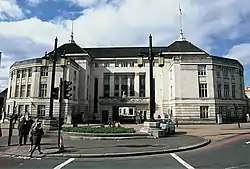London Borough of Wandsworth
Wandsworth (/ˈwɒndzwɜːrθ/ ⓘ) is a London borough in South West London; it forms part of Inner London and has an estimated population of 329,677 inhabitants. Its main named areas are Battersea, Balham, Putney, Tooting and Wandsworth Town.
London Borough of Wandsworth | |
|---|---|
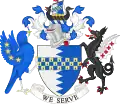 Coat of arms 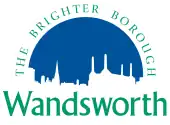 Council logo | |
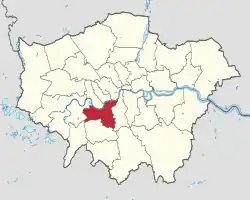 Wandsworth shown within Greater London | |
| Coordinates: 51°27′26.3″N 0°11′41.5″W | |
| Sovereign state | United Kingdom |
| Constituent country | England |
| Region | London |
| Ceremonial county | Greater London |
| Created | 1 April 1965 |
| Admin HQ | Wandsworth |
| Government | |
| • Type | London borough council |
| • Body | Wandsworth London Borough Council |
| • Leadership | Leader & Cabinet (Labour) |
| • Mayor | Jeremy Ambache |
| • London Assembly | Leonie Cooper (Labour) AM for Merton and Wandsworth |
| • MPs | Fleur Anderson (Labour) Rosena Allin-Khan (Labour) Marsha de Cordova (Labour) |
| Area | |
| • Total | 13.23 sq mi (34.26 km2) |
| • Rank | 273rd (of 296) |
| Population (2021) | |
| • Total | 328,367 |
| • Rank | 34th (of 296) |
| • Density | 25,000/sq mi (9,600/km2) |
| Time zone | UTC (GMT) |
| • Summer (DST) | UTC+1 (BST) |
| Postcodes | |
| Area code | 020 |
| ISO 3166 code | GB-WND |
| ONS code | 00BJ |
| GSS code | E09000032 |
| Police | Metropolitan Police |
| Website | www |
The borough borders the London Borough of Lambeth to the east, the London Borough of Merton and the Royal Borough of Kingston upon Thames to the south, the London Borough of Richmond upon Thames to the west, and to the north (across the River Thames) three boroughs, namely the London Borough of Hammersmith and Fulham, the Royal Borough of Kensington and Chelsea and the City of Westminster. The local authority is Wandsworth London Borough Council.
History
Until 1889, the current area of Wandsworth was part of the county of Surrey. In 1855 the Wandsworth District of the Metropolis was formed comprising the parishes of Battersea (excluding Penge), Clapham, Putney, Streatham, Tooting Graveney and Wandsworth. Battersea was removed from the district in 1888. In 1900 the remaining district became the Metropolitan Borough of Wandsworth and Battersea became the Metropolitan Borough of Battersea.
The London Borough of Wandsworth was formed in 1965 from the former area of the Metropolitan Borough of Battersea and the Metropolitan Borough of Wandsworth, but excluding the former parish of Clapham and most of the former parish of Streatham, which were transferred to the London Borough of Lambeth. The areas to the west of Clapham Common in the current borough of Wandsworth are often incorrectly referred to as Clapham, but are in fact part of Battersea parish.[1]
Geography
Clapham Junction railway station is in Battersea, rather than Clapham in the borough. There are many new or refurbished buildings along the borough's prosperous riverside including the large Chelsea Bridge Wharf. The Peace Pagoda, one of many such international pagodas, is in Battersea Park, a sprawling rectangle often hosting circuses beside the Thames. The London Heliport, London's main and busiest heliport, is just beyond Battersea Park, and south of this is New Covent Garden Market. In terms of size, South Thames College, Southside Shopping Centre, Wandsworth and The Exchange Shopping Centre, Putney are among the largest secular structures.
Secular architecturally most highly listed buildings include: Battersea Power Station, the Battersea Arts Centre (formerly town hall), Royal Hospital for Neuro-disability, Wandsworth Town Hall, as well as particularly the interiors of the large Gala Bingo Club, Tooting, the former Granada Theatre, St John's Hill, Clapham Junction by Theodore Komisarjevsky, and in terms of ornate mansions a cluster of five large stone and brick buildings mostly converted to diverse public uses in and around Queen Mary's Hospital, Roehampton at grade II* or above.[2] In Old Battersea two fine masonry mansions survived The Blitz: Old Battersea House [3] and Downshire House[4]—both hold rare Grade II* status.
Demographics
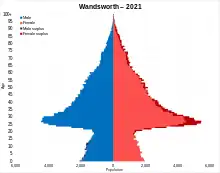
Population
According to the 2021 census, Wandsworth has a population of 327,506. In 2021, 67.8% of the population was white, 10.1% black and 11.6% Asian.
A 2017 study by Trust for London and the New Policy Institute found that Wandsworth has the lowest rate of unemployment of any London borough. It also has the 2nd lowest rate of local employees who are low-paid.[5]
| Year | Pop. | ±% |
|---|---|---|
| 1801 | 12,087 | — |
| 1811 | 15,303 | +26.6% |
| 1821 | 17,779 | +16.2% |
| 1831 | 19,681 | +10.7% |
| 1841 | 23,959 | +21.7% |
| 1851 | 30,241 | +26.2% |
| 1861 | 74,569 | +146.6% |
| 1871 | 118,896 | +59.4% |
| 1881 | 163,224 | +37.3% |
| 1891 | 243,427 | +49.1% |
| 1901 | 306,090 | +25.7% |
| 1911 | 384,884 | +25.7% |
| 1921 | 394,964 | +2.6% |
| 1931 | 405,317 | +2.6% |
| 1941 | 375,040 | −7.5% |
| 1951 | 347,025 | −7.5% |
| 1961 | 323,064 | −6.9% |
| 1971 | 300,832 | −6.9% |
| 1981 | 252,242 | −16.2% |
| 1991 | 265,058 | +5.1% |
| 2001 | 260,383 | −1.8% |
| 2011 | 306,995 | +17.9% |
| Note:[6] | ||
Ethnicity
| Ethnic Group | Year | |||||||||
|---|---|---|---|---|---|---|---|---|---|---|
| 1981 estimations[7] | 1991[8] | 2001[9] | 2011[10] | 2021[11] | ||||||
| Number | % | Number | % | Number | % | Number | % | Number | % | |
| White: Total | 200,184 | 81.2% | 201,821 | 80% | 202,978 | 78.0% | 219,216 | 71.4% | 222,090 | 67.8% |
| White: British | – | – | – | – | 168,665 | 64.8% | 163,739 | 53.3% | 157,048 | 48.0% |
| White: Irish | – | – | – | – | 8,151 | 3.1% | 7,664 | 2.5% | 8,061 | 2.5% |
| White: Gypsy or Irish Traveller | – | – | – | – | – | – | 163 | 0.1% | 120 | 0.0% |
| White: Roma | – | – | – | – | – | – | – | – | 1,730 | 0.5% |
| White: Other | – | – | – | – | 26,162 | 10.0% | 47,650 | 15.5% | 55,131 | 16.8% |
| Asian or Asian British: Total | – | – | 19,543 | 7.7% | 20,271 | 7.8% | 33,338 | 10.9% | 38,314 | 11.6% |
| Asian or Asian British: Indian | – | – | 7700 | 7,412 | 2.8% | 8,642 | 2.8% | 9,599 | 2.9% | |
| Asian or Asian British: Pakistani | – | – | 4198 | 5,449 | 2.1% | 9,718 | 3.2% | 12,249 | 3.7% | |
| Asian or Asian British: Bangladeshi | – | – | 1020 | 1,099 | 0.4% | 1,493 | 0.5% | 1,639 | 0.5% | |
| Asian or Asian British: Chinese | – | – | 2077 | 2,227 | 0.9% | 3,715 | 1.2% | 4,658 | 1.4% | |
| Asian or Asian British: Other Asian | – | – | 4548 | 4,084 | 1.6% | 9,770 | 3.2% | 10,169 | 3.1% | |
| Black or Black British: Total | – | – | 26,815 | 10.6% | 25,066 | 9.6% | 32,756 | 10.7% | 33,062 | 10.1% |
| Black or Black British: African | – | – | 7303 | 10,013 | 3.8% | 14,818 | 4.8% | 17,330 | 5.3% | |
| Black or Black British: Caribbean | – | – | 15305 | 12,665 | 4.9% | 12,297 | 4.0% | 11,356 | 3.5% | |
| Black or Black British: Other Black | – | – | 4207 | 2,388 | 0.9% | 5,641 | 1.8% | 4,376 | 1.3% | |
| Mixed or British Mixed: Total | – | – | – | – | 8,728 | 3.4% | 15,241 | 5.0% | 20,598 | 6.3% |
| Mixed: White and Black Caribbean | – | – | – | – | 2,893 | 1.1% | 4,642 | 1.5% | 5,340 | 1.6% |
| Mixed: White and Black African | – | – | – | – | 1,252 | 0.5% | 2,034 | 0.7% | 2,494 | 0.8% |
| Mixed: White and Asian | – | – | – | – | 2,247 | 0.9% | 3,887 | 1.3% | 5,776 | 1.8% |
| Mixed: Other Mixed | – | – | – | – | 2,336 | 0.9% | 4,678 | 1.5% | 6,988 | 2.1% |
| Other: Total | – | – | 4246 | 1.7% | 3,337 | 1.3% | 6,444 | 2.1% | 13,442 | 4.1% |
| Other: Arab | – | – | – | – | – | – | 2,350 | 0.8% | 3,860 | 1.2% |
| Other: Any other ethnic group | – | – | 4246 | 1.7% | 3,337 | 1.3% | 4,094 | 1.3% | 9,582 | 2.9% |
| Ethnic minority: Total | 46,490 | 18.8% | 50,604 | 20% | 57,402 | 22.1% | 87,779 | 28.7% | 105,416 | 32.2% |
| Total | 246,674 | 100% | 252,425 | 100% | 260,380 | 100.00% | 306,995 | 100.00% | 327,506 | 100% |
Civic affairs
Mayor
The first Mayor of Wandsworth was John Lidiard, elected by the first Wandsworth Borough Council in November 1900.[12][13] Lidiard's initials are highlighted in the diamonds in the centre of the Mayor's chain of office.[14] The second Mayor was Sir William Lancaster.[15]
The current Mayor is Juliana Annan.[16]
Armorial bearings
The armorial bearings retain many of the features of the arms of the former Metropolitan Borough of Battersea and Metropolitan Borough of Wandsworth.
The fess, or crossing, of the shield is chequered blue and gold representing the arms of William de Warren, created first Earl of Surrey by William Rufus. Each gold square bears a teardrop representing the tears of the French Huguenots, many of whom settled in Wandsworth from 1685.
The ship at the top may refer to the Wendels, a tribe of sea-raiders from the Continent who supposedly gave their name to the district, for Wendelsworth was an early variation of Wandsworth. The four shields and oars on the ship represent the four parishes of Battersea, Putney, Tooting and Wandsworth.
The dove to the left is taken from the former Battersea coat of arms and the black dragon to the right was taken from the former Wandsworth arms and also refers to London, being similar to the City of London coat of arms.
Greater London representation
For elections to the Greater London Council, the borough formed the Wandsworth electoral division, electing four members. In 1973 it was divided into the single-member Battersea North, Battersea South, Putney and Tooting electoral divisions.[17] The Greater London Council was abolished in 1986.
Since 2000, for elections to the London Assembly, the borough forms part of the Merton and Wandsworth constituency.
Twin and partner towns
Villers-Plouich,  France
France
The Borough is informally twinned with the village of Villers-Plouich, in Northern France. This association dates back to World War I, following the role played by the Wandsworth Battalion in the liberation of Villers-Plouich in 1917, and again, following recapture, in 1918. Writing in the 'Wandsworth Borough News' in 1920, Robert H Harker, a Lieutenant in the Battalion, described the cemetery in the village as "an inseparable link between our great Borough and that village of Villers-Plouich, near the Somme".[18]
For his courage and determination during the hostilities, Corporal Edward Foster, of Tooting, was awarded both the Victoria Cross and the Médaille militaire.[19] A green heritage plaque was unveiled at his former home at Tooting in 2017,[20] and in 2018 a memorial in his name was established on the outskirts of Villers-Plouich.[21]
Following the end of the War the village was adopted by the then Metropolitan Borough of Wandsworth under the British 'League of Help' scheme,[22] and funds were donated towards its reconstruction. A deputation from Wandsworth regularly visits to commemorate this connection, most recently in 2018.[23]
Schiedam,  Netherlands
Netherlands
Wandsworth first established a twin town arrangement with Schiedam, in the Netherlands, in 1946.[24] A number of refugees from Schiedam who had lived for a time in Wandsworth during World War II hoped to maintain their connections with the London Borough during peacetime.[25] The twinning was organised within the scope of the Dutch-English Sports Plan.[24] In subsequent years multiple sporting fixtures between teams from the two areas were arranged including football,[26] swimming,[27] gymnastics,[28] korfball (Wandsworth has a korfball club, at Tooting)[29] and cricket (Shiedam is one of the strongholds for cricket in the Netherlands).[30]
For many years the wartime connections were acknowledged during annual Remembrance Day commemorations in the two municipalities, either through an exchange of wreaths or by sending a representative.[31] Within the context of both inter-business exchange and sporting fixtures, visits were also arranged by specific Wandsworth organisations such as Small Electric Motors[32] and the Rediffusion factory,[33] as guests of their counterparts at Schiedam companies such as Wilton Personnel and Pieterman Glass.[34][35]
In 1970 a large delegation from Wandsworth visited Schiedam for celebrations marking the 25th anniversary of the town's liberation.[36][37][38] Further sporting and cultural exchanges continued through to at least 1977.[39] However, in 1997, an article in the Dutch local press observed that the relationship with Wandsworth had lapsed.[40]
Politics
Wandsworth London Borough Council
Wandsworth is administered by 58 councillors. After the May 2022 election, 35 of these councillors were Labour and 22 were Conservatives, with 1 independent. The Conservatives had had an overall majority on the council since 1978 until Labour won control in the 2022 election.
Summary results of elections
| Overall control | Conservative | Labour | Lib Dem or Social Democrat |
Others | |
|---|---|---|---|---|---|
| 2022 | Labour | 22 | 35 | – | 1 |
| 2018 | Conservative | 33 | 26 | – | 1 |
| 2014 | Conservative | 41 | 19 | – | – |
| 2010 | Conservative | 47 | 13 | – | – |
| 2006 | Conservative | 51 | 9 | – | – |
| 2002 | Conservative | 50 | 10 | – | – |
| 1998 | Conservative | 50 | 11 | – | – |
| 1994 | Conservative | 45 | 16 | – | – |
| 1990 | Conservative | 48 | 13 | – | – |
| 1986 | Conservative | 31 | 30 | – | – |
| 1982 | Conservative | 33 | 27 | 1 | – |
| 1978 | Conservative | 36 | 25 | – | – |
| 1974 | Labour | 12 | 48 | – | – |
| 1971 | Labour | 7 | 53 | – | – |
| 1968 | Conservative | 48 | 12 | – | – |
| 1964 | Labour | 13 | 47 | – | – |
Transport
Bridges
Five bridges join Wandsworth to the three London Boroughs on the north side of the Thames (from downstream following the river up):
There are also a number of bridges crossing the River Wandle which runs through the centre of Wandsworth town and divides the borough in two.
National Rail Stations
Tube Stations
- On the Northern line:
- On the District line:
National Rail services are operated from London Waterloo by South Western Railway to Earlsfield, Putney, Queenstown Road (Battersea), Wandsworth Town and the borough's largest station, Clapham Junction. This last station is also served from London Victoria by Southern as are Balham, Battersea Park and Wandsworth Common.
London Overground services mainly serve Clapham Junction, which is the southern terminus for the West London Line that has services to Stratford via Shepherd's Bush, though some trains terminate at the West London Line's northern terminus at Willesden Junction. The western terminus for the East London Line also is at Clapham Junction that has services to Highbury & Islington via Denmark Hill. There is also a limited one train a day parliamentary train service that terminates at Battersea Park instead of Clapham Junction.
London Underground services are provided on the District line to East Putney and Southfields and on the Northern line to Battersea Power Station, Balham, Clapham South, Tooting Bec and Tooting Broadway.
Cycling and walking
Wandsworth London Borough Council and Transport for London (TfL) maintain cycling infrastructure in the Borough.
Cycle Superhighway 7 (CS7) is an unbroken, signposted cycle route running through the southeastern portion of the Borough. The route runs along the A24 and A3 roads, through Tooting, Balham, and Clapham. Northbound the route links the Borough directly to the City of London via Kennington, Elephant and Castle, and Southwark. Southbound, the route runs unbroken to Colliers Wood.
Cycle Superhighway 8 (CS8) is an unbroken, signposted cycle route running through the northern edge of Wandsworth, through Battersea. The route runs east-west along the A3205/Battersea Park Road, but the route leaves the Borough to the north over Chelsea Bridge. The route begins in Wandsworth Town and runs to Millbank, City of Westminster, passing Chelsea and the Tate Britain en route.
Although CS8 leaves the Borough to the north, cycling infrastructure is provided along the entire A3205 route between Wandsworth Town and Nine Elms. This means that there is a continuous, signposted cycle route - primarily along designated cycle lanes - from Wandsworth Town and Battersea to Vauxhall, Lambeth, and the South Bank.
Quietway 4 (Q4) runs from Clapham Common to Earlsfield in the Borough, through Wandsworth Common.[41]
The Wandle Trail is a shared-use trail for cyclists and pedestrians between Wandsworth Town and Waddon. The route is signposted and mainly traffic-free. It runs through Earlsfield, Colliers Wood, Morden, Mitcham, and Carshalton along the way.[42]
The Santander Cycles bike-sharing system operates in Putney, Wandsworth Town, and Battersea.[41]
Travel to work
In March 2011, the main forms of transport that residents used to travel to work were (of all residents aged 16–74):
- underground, metro, light rail, tram, 20.7% ;
- train, 10.6%;
- driving a car or van, 10.6%;
- bus, minibus or coach, 9.7%;
- on foot, 5.6%;
- bicycle, 5.4%;
- work mainly at or from home, 4.0%.[43]
Education
Whitelands College was founded Chelsea in 1842 by the Church of England, and heavily under the influence of John Ruskin. In 1930/1931 the college relocated to West Hill (Wandsworth Borough) and occupied an enormous purpose-built site, with buildings designed by Sir Giles Gilbert Scott. These buildings, now listed, were one of the Borough's largest educational sites until 2005 when the College, again moved, this time to a site in Roehampton, where it is now a constituent College of Roehampton University.
The borough's schools include Emanuel School, Graveney School, Southfields Academy, Burntwood School, Ashcroft Technology Academy, Ernest Bevin Academy, Ark Bolingbroke Academy and Ark Putney Academy.
Religion
The dominant religion of the borough is Christianity, although the area is also home to a number of other religious communities. The community is home to a number of Sikhs, Jews, Muslims, Buddhists and Hindus.[44]
According to the 2011 Census, approximately 35% of Wandsworth identified as being non-religious, or chose not to state their faith.[45]
The following shows the religious identity of residents residing in Wandsworth according to the 2001, 2011 and the 2021 censuses.
| Religion | 2001[46] | 2011[47] | 2021[48] | |||
|---|---|---|---|---|---|---|
| Number | % | Number | % | Number | % | |
| Holds religious beliefs | 185,515 | 71.2 | 200,138 | 65.2 | 185,457 | 56.6 |
| Christian | 160,946 | 61.8 | 162,590 | 53.0 | 139,656 | 42.6 |
| Muslim | 13,529 | 5.2 | 24,746 | 8.1 | 32,519 | 9.9 |
| Jewish | 1,691 | 0.6 | 1,617 | 0.5 | 1,756 | 0.5 |
| Hindu | 5,929 | 2.3 | 6,496 | 2.1 | 6,419 | 2.0 |
| Sikh | 651 | 0.3 | 832 | 0.3 | 967 | 0.3 |
| Buddhist | 1,843 | 0.7 | 2,574 | 0.8 | 2,275 | 0.7 |
| Other religion | 926 | 0.4 | 1,283 | 0.4 | 1,871 | 0.6 |
| No religion | 52,042 | 20.0 | 82,740 | 27.0 | 118,543 | 36.2 |
| Religion not stated | 22,823 | 8.8 | 24,117 | 7.8 | 23,500 | 7.2 |
| Total population | 260,380 | 100.0 | 306,995 | 100.0 | 327,500 | 100.0 |
Places
Parks and open spaces
Wandsworth has responsibility for three Metropolitan Open Spaces:
- Battersea Park
- Wandsworth Common
- Tooting Commons – the historically separate, but adjoining, Tooting Bec Common and Tooting Graveney Common
These three large green spaces together with a range of smaller parks and playgrounds (such as Wandsworth Park) are patrolled by Wandsworth Council's own parks police known from 1984 to 2012 as the Wandsworth Parks Police. From April 2012 the Parks Police team of 23 officers was replaced by a smaller Wandsworth Events Police Service (WEPS) working with a team of 12 Metropolitan Police Officers. This system was deemed unsuccessful, and in 2015 the WEPS was rebranded as Wandsworth Parks and Events Police (WPEP) and returned to full staffing levels of 33 police officers and support officers.[49][50]
Also within the borough's boundaries are Putney Heath and part of Putney Lower Common, which are managed as part of Wimbledon Common, and the west side of Clapham Common, which is managed by the London Borough of Lambeth.
Theatres
- Battersea Arts Centre
- Theatre503
- Putney Arts Theatre
- Tara Arts Theatre
Localities
References
- "Where is Battersea". Love Battersea. Retrieved 25 July 2019.
- Map created by Ordnance Survey of listed buildings courtesy of English Heritage Archived 24 April 2012 at the Wayback Machine
- Historic England. "Old Battersea House (1065500)". National Heritage List for England. Retrieved 28 January 2013.
- Historic England. "Devonshire House including railings and gates (1357666)". National Heritage List for England. Retrieved 28 January 2013.
- "London's Poverty Profile". Trust for London. Retrieved 19 June 2018.
- "Wandsworth: Total Population". A Vision of Britain Through Time. Great Britain Historical GIS Project. Retrieved 6 September 2011.
- Equality, Commission for Racial (1985). "Ethnic minorities in Britain: statistical information on the pattern of settlement". Commission for Racial Equality: Table 2.2.
- "1991 census – theme tables". NOMIS. Retrieved 20 January 2017.
- "KS006 - Ethnic group". NOMIS. Retrieved 30 January 2016.
- "Ethnic Group by measures". NOMIS. Retrieved 8 January 2016.
- "Ethnic group - Office for National Statistics". www.ons.gov.uk. Retrieved 29 November 2022.
- "The London Borough Councils. Election of Mayors and Aldermen". The Times. 10 November 1900. p. 14.
- Local History Publications 1955–2011. Index for Researchers. Wandsworth Historical Society. p. 12.
- "The Mayors of Wandsworth". Wandsworth Council. Archived from the original on 4 April 2013. Retrieved 9 May 2013.
- "Blue Plaques Scheme" (PDF). Putney Society. Archived (PDF) from the original on 2 April 2015. Retrieved 30 March 2014.
- "Mayor of Wandsworth". Retrieved 16 September 2023.
- Boothroyd, David. "Greater London Council Election results: Wandsworth". United Kingdom Election Results. Archived from the original on 24 March 2016. Retrieved 29 August 2023.
- McCue, Paul (1 January 2010). Wandsworth and Battersea Battalions in the Great War. Casemate Publishers. ISBN 978-1-84884-194-9.
- "Account of Ted Foster's actions written by James Price Lloyd of the Welsh Regiment (26 March 1918)". europeana.
- Geoff (10 April 2017). "Tiny Ted's Tooting". Summerstown182. Retrieved 19 May 2022.
- "Memorial to war hero 'Tiny Ted'". Wandsworth Borough Council. Retrieved 14 May 2022.
- McCue, Paul (1 January 2010). Wandsworth and Battersea Battalions in the Great War. Casemate Publishers. ISBN 978-1-84884-194-9.
- "Wandsworth's wartime links with village in France renewed with memorial unveiled to Ted Foster VC and gift of iconic red telephone box". Wandsworth Borough Council. Retrieved 14 May 2022.
- "In afwachting van het officiële bericht betreffende de adoptie van Schiedam door de Londense voorstad Wandsworth". scyedam.delinea.nl. Retrieved 13 June 2022.
- "Het Nieuwe Stadsblad | 20 juni 1975 | pagina 13". Gemeentearchief Schiedam - Krantenkijker (in Dutch). Retrieved 13 June 2022.
- "Grootse ontvangst van de Engelse gasten en uitbundige viering van het Koninginnefeest ter gelegenheid van de verjaardag van koningin Wilhelmina". scyedam.delinea.nl. Retrieved 13 June 2022.
- "In het Sportfondsenbad winnen Schiedamse zwemmers de Paroolwisselbeker in een wedstijd tegen zwemmers uit Wandsworth-Engeland". scyedam.delinea.nl. Retrieved 13 June 2022.
- "In het Passage Theater geven gymnastiekverenigingen uit Schiedam en Wandsworth een zeer geslaagde show in het uitverkochte theater". scyedam.delinea.nl. Retrieved 13 June 2022.
- beckorfballclub (20 November 2021). "Momentous occasion for Bec Korfball Club". beckorfballclub. Retrieved 6 July 2022.
- "Hail Holland, world cricket's unlikely lads". Financial Times. 5 March 2007. Archived from the original on 10 December 2022. Retrieved 27 July 2022.
- "Overzichtsfoto van de jaarlijkse kransleggingsplechtigheid bij het oorlogsmonument aan 'de kop van de Plantage' t". Oorlogs Bronnen.
- "Groups from Rediffusion and Small Electric Motors arrive in the Netherlands (1949)". europeana.
- "Commemorative ashtray with inscription Rediffusion/Wilton Fijenoord/Whitsuntide (1947)". europeana.
- "Op de werf Wilton-Fijenoord arriveert een groep Engelse gasten van de Rediffusion fabrieken uit Wandsworth". scyedam.delinea.nl. Retrieved 13 June 2022.
- "Er arriveren twintig personeelsleden van de firma Benham en Co uit Wandsworth voor een vierdaags bezoek aan Schiedam". scyedam.delinea.nl. Retrieved 13 June 2022.
- "Vote of thanks from Wandsworth Council to the people of Schiedam (1970)". europeana.
- "Rotterdamsch Parool / De Schiedammer | 17 april 1970 | pagina 2". Gemeentearchief Schiedam - Krantenkijker (in Dutch). Retrieved 13 June 2022.
- "Het Nieuwe Stadsblad | 8 mei 1970 | pagina 10". Gemeentearchief Schiedam - Krantenkijker (in Dutch). Retrieved 13 June 2022.
- "Het Nieuwe Stadsblad | 6 juli 1977 | pagina 8". Gemeentearchief Schiedam - Krantenkijker (in Dutch). Retrieved 13 June 2022.
- "Musis | 1 april 1997 | pagina 127". Gemeentearchief Schiedam - Krantenkijker (in Dutch). Retrieved 13 June 2022.
- "Cycle". Transport for London. Retrieved 5 April 2020.
- "The Wandle Trail Walk and Cycle Route" (PDF). London Borough of Merton. Archived (PDF) from the original on 3 August 2020. Retrieved 5 April 2020.
- "2011 Census: QS701EW Method of travel to work, local authorities in England and Wales". Office for National Statistics. Retrieved 23 November 2013. Percentages are of all residents aged 16–74 including those not in employment (26.7%). Respondents could only pick one mode, specified as the journey's longest part by distance.
- "Wandsworth Census Demographics United Kingdom". localstats.co.uk. Retrieved 18 March 2018.
- "2011 Census data and analysis". Wandsworth.gov.uk. 2017. Retrieved 3 June 2017.
- "KS007 - Religion - Nomis - 2001". www.nomisweb.co.uk. Retrieved 18 October 2022.
- "KS209EW (Religion) - Nomis - 2011". www.nomisweb.co.uk. Retrieved 18 October 2022.
- "Religion - 2021 census". Office of National Statistics. 29 November 2022. Archived from the original on 29 November 2022. Retrieved 16 December 2022.
- "Archived copy". Archived from the original on 7 January 2014. Retrieved 26 December 2019.
{{cite web}}: CS1 maint: archived copy as title (link) - "Wandsworth Parks and Events Police". British Police History. Retrieved 11 February 2019.
